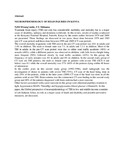| dc.contributor.author | Mwang’ombe, NJM | |
| dc.contributor.author | Shitsama, S V | |
| dc.date.accessioned | 2013-11-29T15:43:44Z | |
| dc.date.available | 2013-11-29T15:43:44Z | |
| dc.date.issued | 2013-06 | |
| dc.identifier.citation | Mwang’ombe NJM, Shitsama S V;Neuroepidemiology Of Head Injuries In Kenya,presented at the 2nd International Scientific Conference, Chs And Knh, 19th - 21st June 2013. | en |
| dc.identifier.uri | http://hdl.handle.net/11295/61243 | |
| dc.description | Neuroepidemiology Of Head Injuries In Kenya,presented at the 2nd International Scientific Conference, CHS And KNH, 19th - 21st June 2013. | en |
| dc.description.abstract | Traumatic brain injury (TBI) not only has considerable morbidity and mortality
but is a major cause of disability, epilepsy and dementia worldwide. In this review,
results of studies conducted at the Kenyatta National Hospital, Nairobi, Kenya
by the senior author between 1979 and 2009 are presented. These findings are
discussed in two parts, those done between 1979 and 1985 (pre-CT scan period)
and those done between 1999 and 2009 (CT scan period).
The overall mortality in patients with TBI seen in the pre-CT scan period was
16% in adults and 1.4% in children. The male to female ratio was 7:1. in adults
and 1.1:1 in children. Most of the TBI in adults in the pre-CT scan period were due
to either road traffic accidents (46%) or assaults (40%), while a different pattern
was observed in children, with falls from a height being most frequent (50%)
followed closely by road traffic accidents (42%). In this group, the frequency of
early seizures was 4% in adults and 8% in children. In the second study group
of CT scan era TBI patients, the male to female ratio in patients with severe TBI
(GCS 8 and below) was 8:1 while the overall mortality was 57% (60% of the
patients dying within 48 hours of admission).
In the earlier years in this second study group (1992-1996), skull radiograph
was the investigation of choice in patients with severe TBI (74%), CT scan of
the head being done in only 24% of the patients, while in the later years (2009)
CT scan of the head was done in all the patients with severe TBI. Brain oedema
was the commonest CT scan finding in this second study group and 40% of the
patients diagnosed with brain oedema had a poor outcome.
Other factors associated with a poor outcome in this group were abnormal pupillary
reaction to light, hypotension (MAP< 70mmHg) and hypoglycaemia (blood
glucose <10mmol/l). In this paper, the Global perspective of neuroepidemiology
of TBI in low and middle income countries of sub-Saharan Africa, its role as
a major cause of death and disability and possible preventive measures, are
discussed. | en |
| dc.language.iso | en | en |
| dc.publisher | University of Nairobi | en |
| dc.title | Neuroepidemiology Of Head Injuries In Kenya | en |
| dc.type | Presentation | en |
| local.publisher | College of Health Sciences | en |

